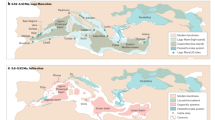Abstract
DINOFLAGELLATES and Trichodesmium are the algae most commonly responsible for the discolorations of the sea known as red tides. These blooms are rarely observed until their development is complete, so that the events which lead to red tides remain enigmatic. Dinoflagellates are distinguished by their relatively large size compared with other flagellated algae, and by their greater swimming speeds. Many of them produce substances which when released into the water are toxic to animals. Usually any toxin released is probably either destroyed or diffused as rapidly as it is produced, and the species remains harmless, but in special circumstances, not yet adequately identified, the dinoflagellate and its toxin become very abundant and a red tide occurs, which, if prolonged, may be followed by mass mortality of fish and other organisms. Trichodesmium is also motile in the sense that it can produce gas vacuoles which cause it to rise in the water column.
This is a preview of subscription content, access via your institution
Access options
Subscribe to this journal
Receive 51 print issues and online access
$199.00 per year
only $3.90 per issue
Buy this article
- Purchase on Springer Link
- Instant access to full article PDF
Prices may be subject to local taxes which are calculated during checkout
Similar content being viewed by others
References
Brongersma-Sanders, M., Mem. geol. Soc. Am., 67, 941 (1957).
Rounsefell, G. A., and Nelson, W. R., Spec. scient. Rep. U. S. Fish. Wildl. Serv., Fish., 535 (1966).
Steele, J. H., Mem. Ist. ital. Idrobiol., 18, 383 (1965).
Jerlov, N. G., Rep. Swed. deep Sea Exped., 3, 1 (1951).
Lumb, F. E., Q, Jl R. met. Soc., 90, 43 (1964).
Prakash, A., Medcof, J. C., and Tennant, A. D., Bull. Fish. Res. Bd Can., 177 (1971).
Aldrich, D. V., Science, N. Y., 137, 988 (1962).
Slobodkin, L. B., J. mar. Res., 12, 148 (1953).
Sykes, J. E., Spec. scient. Rep. U.S. Fish. Wildl. Serv., Fish., 521, 9 (1965).
Strickland, J. D. H., Holm-Hansen, O., Eppley, R. W., and Linn, R. J., Limnol. Oceanogr., 14, 23 (1969).
Author information
Authors and Affiliations
Rights and permissions
About this article
Cite this article
WYATT, T., HORWOOD, J. Model which Generates Red Tides. Nature 244, 238–240 (1973). https://doi.org/10.1038/244238a0
Received:
Revised:
Published:
Issue Date:
DOI: https://doi.org/10.1038/244238a0
This article is cited by
-
The role of algae in agriculture: a mathematical study
Journal of Biological Physics (2017)
-
Ocean plankton populations as excitable media
Bulletin of Mathematical Biology (1994)
-
Particle rejection by Calanus pacificus: discrimination between similarly sized particles
Marine Biology (1983)
-
Nutrient regeneration by zooplankton during a red tide off Peru, with notes on biomass and species composition of zooplankton
Marine Biology (1978)
-
Observations on the diel migration of marine dinoflagellates off the Baja California coast
Marine Biology (1978)
Comments
By submitting a comment you agree to abide by our Terms and Community Guidelines. If you find something abusive or that does not comply with our terms or guidelines please flag it as inappropriate.



